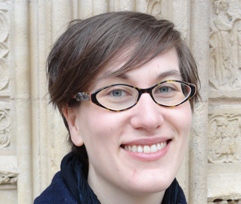
March 11, 2014, by Guest blogger
For the love of the Gothic Revival
Dr Ayla Lepine explains how she started studying History and English in Canada and ended up in The University of Nottingham Art History department.
When I began my BA at the University of Victoria in British Columbia, Canada I was unshakably determined that I would complete a double major in History and English Literature and that I would love it.
Part way through my studies, a friend told me how much he was enjoying his Art History course. I was intrigued, but also anxious about changing my major and as a result, delaying graduation. Despite my concerns, I decided to take an Art History elective. I chose the most boring topic I could find – critical theory – to test whether it really was as compelling a field as my friend had claimed. It was amazing. I changed my major.
As I studied further, I became particularly interested in Islamic and Christian architecture and the relationship between theology and architectural history. This intersection between two fields of study fascinated me so much that I decided to take two more radical steps: I moved to England, and I began postgraduate study in Theology.
After spending a year at Oxford exploring theology I began to notice something. My knowledge was growing but I missed Art History and the opportunity it provides to connect cultural discourse with interpretations of objects and buildings. As a Canadian abroad who had to pay international fees, I had to weigh the cost of student loans against the value of studying what I had discovered I really cared about: Victorian church architecture. I was fortunate enough to win a scholarship to the Courtald Institute of Art in London where I completed my MA in 2005 and my PhD in 2011.
While specializing in the Gothic Revival (think Houses of Parliament, the Albert Memorial, Truro Cathedral, and hundreds of Victorian churches by architects like William Butterfield, George Edmund Street, and George Frederick Bodley), I also worked for a conservation architecture firm as a researcher. This gave me invaluable hands-on experience and also encouraged me to join advocacy groups like the Victorian Society and the Twentieth Century Society to help save these valuable heritage buildings for everyone to learn from and enjoy.
I arrived at Nottingham’s Art History Department in September 2013. It’s a great place to teach, learn, research, and publish. As an art historian, I tend to think of my own role in the discipline as someone that connects people; this can mean working with students to give them great access to professional and academic contacts, or collaborating with colleagues on innovative research that helps make sense of the legacies of human imagination within sacred traditions and the arts.
Art History tells us why and how people are creative. Studying beauty, design, and images demands hard work, close attention, and critical thinking. Architecture and the arts sustain and shape our world. I encourage my students who are searching for real meaning in their studies to read widely, keep eyes and minds wide open, and combine intuition with strong mentoring.
Read more from other students, academics and employers on the Study What You Love pages.
No comments yet, fill out a comment to be the first

Leave a Reply